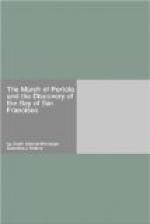In 1585, Captain Francisco de Gali, sailing for the Philippines, was directed to sail, on the return voyage, as far north as the weather would permit, and on reaching the coast of California, examine the land and the harbors on his way homeward, make maps of all, and report all that he accomplished. It does not appear from Gali’s report that he accomplished anything in particular. He reached the coast in latitude 37deg. 30’ (Pillar Point), and noted that the land was high and fair; that the mountains[1] were without snow, and that there were many indications of rivers, bays, and havens along the coast.
In 1594, Captain Sebastian Cermenon, a Portuguese sailor in the service of Spain, sailed for the Philippines with orders similar to those of Gali. In an attempt to survey the coast, he lost his ship, the San Agustin. It is supposed she struck on one of the Farallones and was beached in Drake’s Bay. From the trunk of a tree they constructed a boat, called a viroco, and in this the ship’s company of more than seventy persons continued the homeward voyage. The little vessel reached Puerto de Navidad in safety, and here the commander and part of the company left it in charge of the pilot, Juan de Morgana, with a crew of ten men, who brought it into Acapulco on the 31st of January, 1596; a most remarkable voyage of nearly twenty-five hundred miles by shipwrecked, sick, and hungry men, crowded into an open boat. With the loss of the San Agustin, explorations of the California coast by laden ships from the Philippines came to an end.
Sometime prior to the summer of 1595, the viceroy of New Spain, Don Luis de Velasco, entered into an agreement with certain persons looking to the exploration of the coasts of the Californias and the settlement of the land. The consideration for this undertaking, which was to be at the expense of the adventurers, was the privilege of pearl fishing and trade, together with all the honors, favors, and exemptions usually given to the pacifiers and settlers of new provinces. Preparations for the expedition were under way, when a dispute arose between the leader and his partners in the enterprise, and the matter was carried into the courts. Before a decision was reached, the leader died, and the judge ordered the other partners, among whom was one Sebastian Vizcaino, to begin the voyage to the Californias within three months. Under this order, Vizcaino applied to Viceroy Velasco, and received his permission to make the journey. This was the condition of affairs when, on October 5, 1596, Velasco was relieved and a new viceroy, Don Gaspar de Zuniga y Azevedo, Count of Monterey, took command. At Velasco’s request, Zuniga made a careful examination of all matters pertaining to the expedition to the Californias, and the result was not favorable to Vizcaino. The new viceroy did not think that an enterprise which might involve results of such vast importance should be entrusted to the leadership of a person of such obscure position




